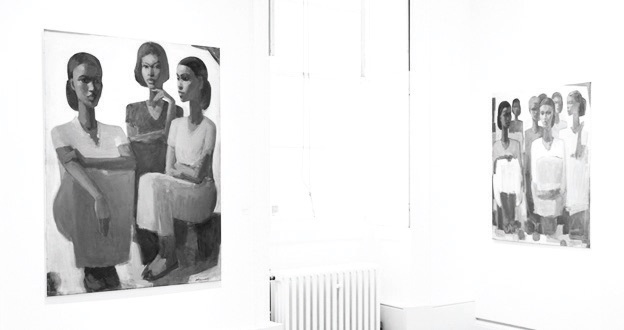
BY STAFF REPORTER
As Ethiopia recovers from decades of political turbulence, the entrepreneurs of Addis Ababa have stepped up to show the world all their country has to offer. While guidebooks to Addis tend to focus on history and tradition, the members of the city’s rising artistic community are turning galleries, clubs, and even hotels into a celebration of creativity to come.
Addis Ababa has all the hallmarks of a capital city in a booming economy: half-constructed concrete structures loom at every corner, international businessmen loudly discuss deals in hotel lobbies, and store windows tout glitzy dresses and sharp suits to draw in members of an emergent middle class. Tourists, too, are drawn by the appeal of a flourishing destination; in 2018, Ethiopia’s travel and tourism economy grew by 48.6 percent.
Visitors are often pointed in the direction of coffee ceremonies, cultural shows featuring traditional music and dance, a collection of churches, and Lucy, a three-million-year-old hominid skeleton discovered in 1974. But for those willing to venture beyond the tourist circuit, Addis offers a modern and individually Ethiopian creative scene.
Though Ethiopia has a rich tradition of both fine art and music, the country’s artistic output came to a standstill in the 1970s. A military coup overthrew Emperor Haile Selassie and installed a Marxist Derg that ruled with an iron fist until 1991. As the country recovered from decades of repressive authoritarian rule and the years of protests and instability that followed the Derg’s fall, members of the Ethiopian diaspora returned home and creative expression slowly ramped up.
Today, it’s exploding. As Prime Minister Abiy Ahmed (PhD) introduces a slew of reforms that make it easier to do business and possible to speak out, artistically driven entrepreneurs are creating ventures that inspire both individual expression and collective engagement with the arts.
Upon arriving for a six-month stint in Addis, I realized there was still no neatly curated arts-and-culture guide to plug me in to everything happening on the cutting edge of creativity. Instead, I treated Facebook events, Telegram groups, posters pinned up in local cafes, and the ever-reliable word of mouth as bread crumbs—and discovered a collaborative, community-focused landscape of initiatives.
One deliciously warm Saturday, I find myself in the flower-filled courtyard of Addis’s most luxurious hotel, the Sheraton. There are expats wrapped around the gates, in line for a “Diplomatic Bazaar” on the hotel’s palatial grounds, with vendors selling pantry staples imported from around the world. Others are headed to the basement event-space showcasing a vast range of colorful, textured work by rising Ethiopian artists for the 11th annual Art of Ethiopia exhibition; I’m especially drawn to artist Kidist Berhane’s explosive depictions of chaotic crowds of chickens.
Another weekend, I’m surrounded by lush greens as I enjoy a refreshing ginger juice in the garden cafe of the Zoma Museum. An environmentally conscious contemporary art center, Zoma features a gallery space for rotating exhibitions, an edible garden, a children’s school and learning area, and a library well stocked with art history tomes and magazines. Zoma’s biggest draw, however, is arguably the space itself: The museum’s walls are built out of mud and straw using traditional wattle-and-daub techniques, and artist and Zoma cofounder Elias Sime has carved patterns that transform them into striking sculptured surfaces.
I also begin to spend my Thursday evenings at the African Jazz Village, a circular space with a sunken seating area attached to the Ghion Hotel. The club is the brainchild of Mulatu Astatkie, the legendary musician renowned as the father of Ethio-Jazz, a funky fusion of Afrobeat, Ethiopian tribal music, and jazz sounds.
I’m told that Mulatu’s goal was to provide a space for up-and-coming groups from across East Africa to perform and collaborate. And it is this very idea—of passing the mantle and creating community—that I find to be the connecting thread between many of the artistic entrepreneurs I meet in Addis.
One standout pioneer in collective creativity is Rakeb Sile, cofounder of Addis Fine Art, the first contemporary art gallery in the city to offer artists international representation. Rakeb spent her formative years in Addis before moving to the U.K. for high school. Being so far away from home sparked her interest in Ethiopian art.
“I wanted to see familiar things that helped me feel connected to home, and so I started collecting art,” she says. But as she attempted to uncover details about her acquisitions, she realized how little information was available about art coming out of the Horn of Africa.
The desire to learn more about Ethiopian art gradually transformed into a desire to promote Ethiopian art abroad, and her personal curation grew from a passion project into Addis Fine Art.
“There is no reason that artists [in Addis Ababa] can’t have the same commercial success as artists anywhere else in the world,” says Rakeb. Describing the project as “artist-centric,” she is most motivated by the ability to offer opportunities for success to artists who might not have had them otherwise.
As international as the focus of Addis Fine Art may often seem, Rakeb is equally committed to driving interest in and appreciation for the art within Ethiopia. “Right now, there is a lot of speculation happening around African art, and it’s important that local people have the opportunity to buy the art that’s from here,” she says. “We’re doing a lot of education on the client side to develop local collecting because Ethiopia needs to take the lead in preserving and valuing its own art.”
Another creative working to support the community is Salem Kassahun, founder of Salem’s—the place to buy artisan handicrafts in Addis. Many of the baskets, textiles, and jewelry pieces are made on-site; all are inspired by traditional Ethiopian designs and subtly updated to appeal to the modern eye.
But Salem’s offers much more than beautiful objects and home furnishings for the design-minded. The business was set up to provide sustainable income and employment to as many artisans as possible.
Today, Salem’s has 100 artisans on payroll with plans to add 25 more over the coming months.
“I like to say that Salem’s was founded with both passion and vision. I’ve always loved handicrafts, and my husband worked in social enterprise, so he turned me on to the idea that charity, while well-meaning, can take away dignity, and that creating employment opportunities was a better way to make change,” Salem said.
(Source: heremegazine.com)
THE ETHIOPIAN HERALD JULY 27/2021





